Leadership, Complexity, and Change: Personal Learning Log
VerifiedAdded on 2021/06/30
|19
|6970
|175
Homework Assignment
AI Summary
This assignment is a personal learning log exploring various leadership styles, including transformational, transactional, and situational leadership. The student reflects on their workplace experiences, contrasting a transactional leadership style, which emphasized task completion and pressure, with a transformational approach that fostered employee involvement and growth. The log delves into the feelings associated with each style, highlighting the impact on employee motivation, creativity, and overall job satisfaction. It analyzes the key components of transformational leadership, such as idealized influence, inspiration, intellectual stimulation, and individualized consideration, as well as the characteristics of transactional leadership, including contingent reward and penalization. Furthermore, the assignment explores the situational leadership theory, discussing different leadership approaches and follower maturity levels. The student concludes by considering the advantages and disadvantages of each style, outlining future actions to apply these leadership concepts effectively. The log emphasizes the importance of adapting leadership styles to specific situations and the significance of communication and employee engagement in achieving organizational goals.
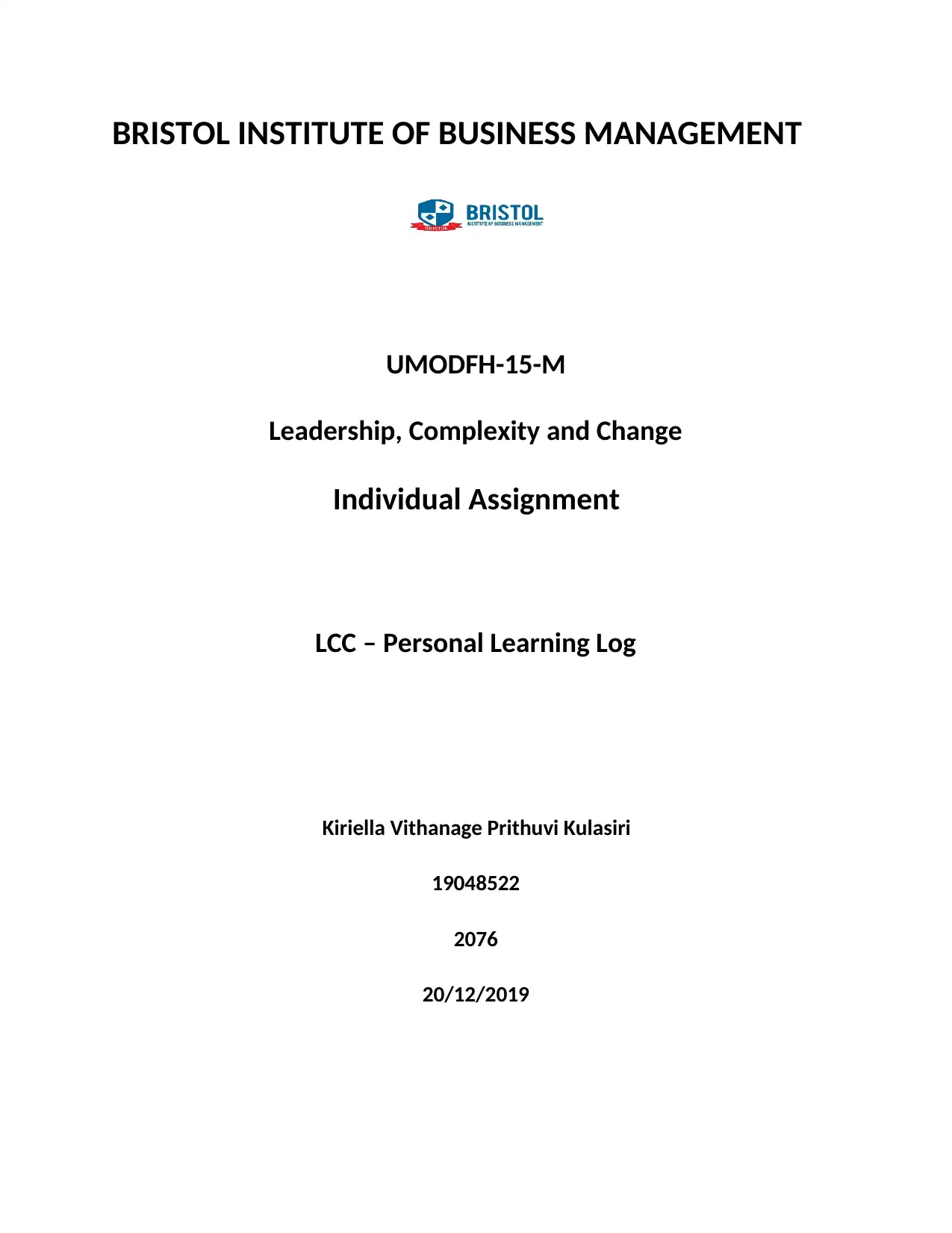
BRISTOL INSTITUTE OF BUSINESS MANAGEMENT
UMODFH-15-M
Leadership, Complexity and Change
Individual Assignment
LCC – Personal Learning Log
Kiriella Vithanage Prithuvi Kulasiri
19048522
2076
20/12/2019
UMODFH-15-M
Leadership, Complexity and Change
Individual Assignment
LCC – Personal Learning Log
Kiriella Vithanage Prithuvi Kulasiri
19048522
2076
20/12/2019
Paraphrase This Document
Need a fresh take? Get an instant paraphrase of this document with our AI Paraphraser
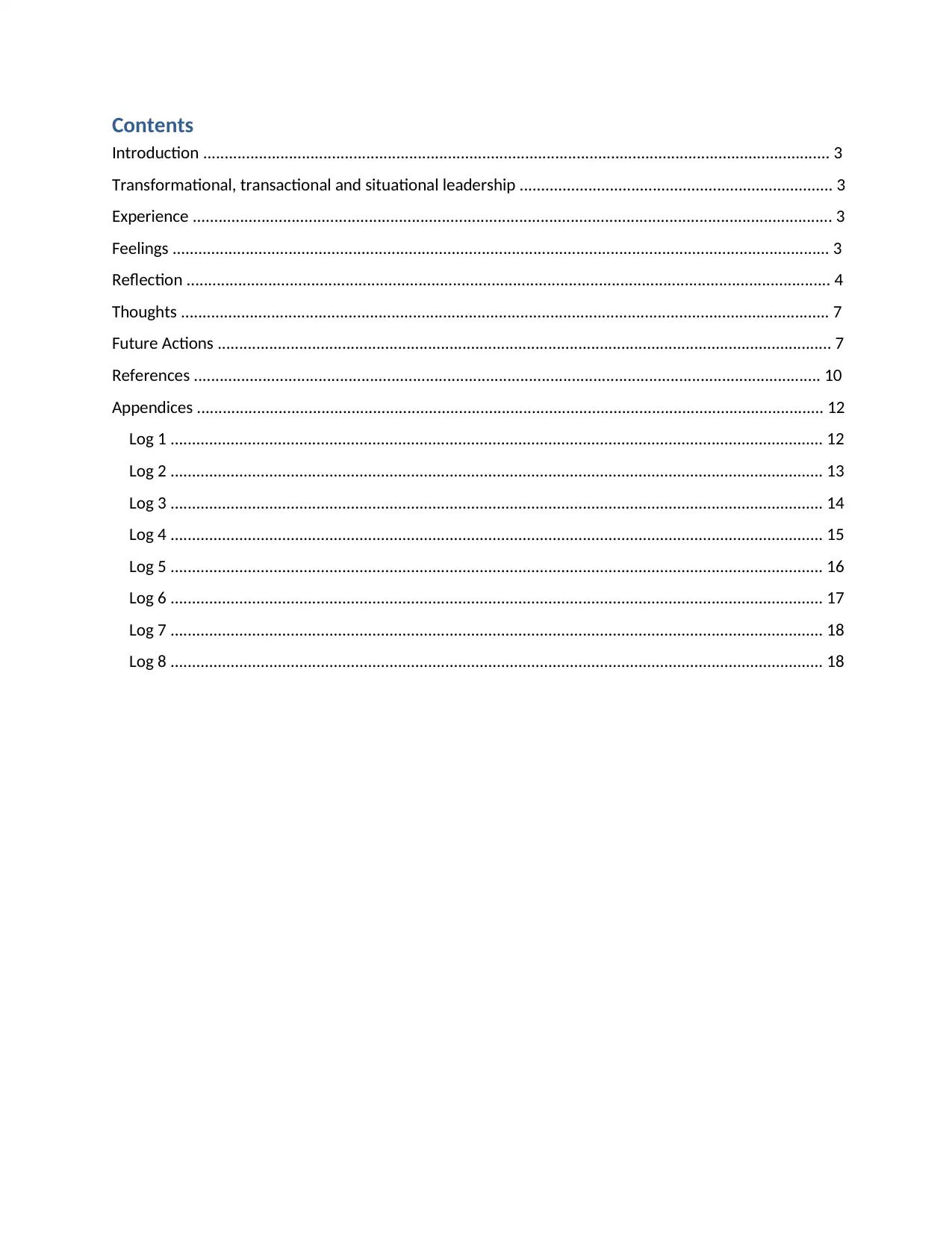
Contents
Introduction .................................................................................................................................................. 3
Transformational, transactional and situational leadership ......................................................................... 3
Experience ..................................................................................................................................................... 3
Feelings ......................................................................................................................................................... 3
Reflection ...................................................................................................................................................... 4
Thoughts ....................................................................................................................................................... 7
Future Actions ............................................................................................................................................... 7
References .................................................................................................................................................. 10
Appendices .................................................................................................................................................. 12
Log 1 ........................................................................................................................................................ 12
Log 2 ........................................................................................................................................................ 13
Log 3 ........................................................................................................................................................ 14
Log 4 ........................................................................................................................................................ 15
Log 5 ........................................................................................................................................................ 16
Log 6 ........................................................................................................................................................ 17
Log 7 ........................................................................................................................................................ 18
Log 8 ........................................................................................................................................................ 18
Introduction .................................................................................................................................................. 3
Transformational, transactional and situational leadership ......................................................................... 3
Experience ..................................................................................................................................................... 3
Feelings ......................................................................................................................................................... 3
Reflection ...................................................................................................................................................... 4
Thoughts ....................................................................................................................................................... 7
Future Actions ............................................................................................................................................... 7
References .................................................................................................................................................. 10
Appendices .................................................................................................................................................. 12
Log 1 ........................................................................................................................................................ 12
Log 2 ........................................................................................................................................................ 13
Log 3 ........................................................................................................................................................ 14
Log 4 ........................................................................................................................................................ 15
Log 5 ........................................................................................................................................................ 16
Log 6 ........................................................................................................................................................ 17
Log 7 ........................................................................................................................................................ 18
Log 8 ........................................................................................................................................................ 18
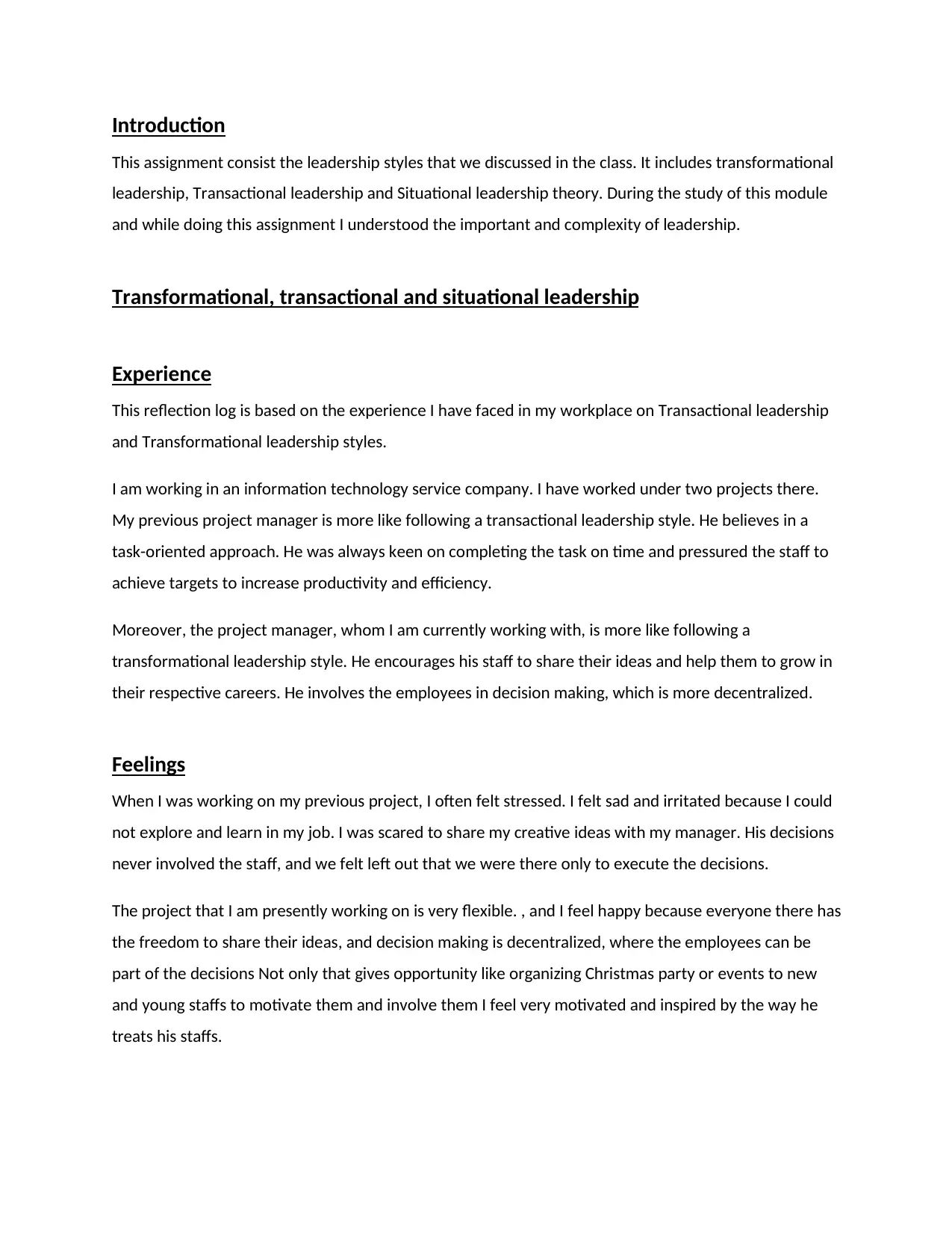
Introduction
This assignment consist the leadership styles that we discussed in the class. It includes transformational
leadership, Transactional leadership and Situational leadership theory. During the study of this module
and while doing this assignment I understood the important and complexity of leadership.
Transformational, transactional and situational leadership
Experience
This reflection log is based on the experience I have faced in my workplace on Transactional leadership
and Transformational leadership styles.
I am working in an information technology service company. I have worked under two projects there.
My previous project manager is more like following a transactional leadership style. He believes in a
task-oriented approach. He was always keen on completing the task on time and pressured the staff to
achieve targets to increase productivity and efficiency.
Moreover, the project manager, whom I am currently working with, is more like following a
transformational leadership style. He encourages his staff to share their ideas and help them to grow in
their respective careers. He involves the employees in decision making, which is more decentralized.
Feelings
When I was working on my previous project, I often felt stressed. I felt sad and irritated because I could
not explore and learn in my job. I was scared to share my creative ideas with my manager. His decisions
never involved the staff, and we felt left out that we were there only to execute the decisions.
The project that I am presently working on is very flexible. , and I feel happy because everyone there has
the freedom to share their ideas, and decision making is decentralized, where the employees can be
part of the decisions Not only that gives opportunity like organizing Christmas party or events to new
and young staffs to motivate them and involve them I feel very motivated and inspired by the way he
treats his staffs.
This assignment consist the leadership styles that we discussed in the class. It includes transformational
leadership, Transactional leadership and Situational leadership theory. During the study of this module
and while doing this assignment I understood the important and complexity of leadership.
Transformational, transactional and situational leadership
Experience
This reflection log is based on the experience I have faced in my workplace on Transactional leadership
and Transformational leadership styles.
I am working in an information technology service company. I have worked under two projects there.
My previous project manager is more like following a transactional leadership style. He believes in a
task-oriented approach. He was always keen on completing the task on time and pressured the staff to
achieve targets to increase productivity and efficiency.
Moreover, the project manager, whom I am currently working with, is more like following a
transformational leadership style. He encourages his staff to share their ideas and help them to grow in
their respective careers. He involves the employees in decision making, which is more decentralized.
Feelings
When I was working on my previous project, I often felt stressed. I felt sad and irritated because I could
not explore and learn in my job. I was scared to share my creative ideas with my manager. His decisions
never involved the staff, and we felt left out that we were there only to execute the decisions.
The project that I am presently working on is very flexible. , and I feel happy because everyone there has
the freedom to share their ideas, and decision making is decentralized, where the employees can be
part of the decisions Not only that gives opportunity like organizing Christmas party or events to new
and young staffs to motivate them and involve them I feel very motivated and inspired by the way he
treats his staffs.
⊘ This is a preview!⊘
Do you want full access?
Subscribe today to unlock all pages.

Trusted by 1+ million students worldwide
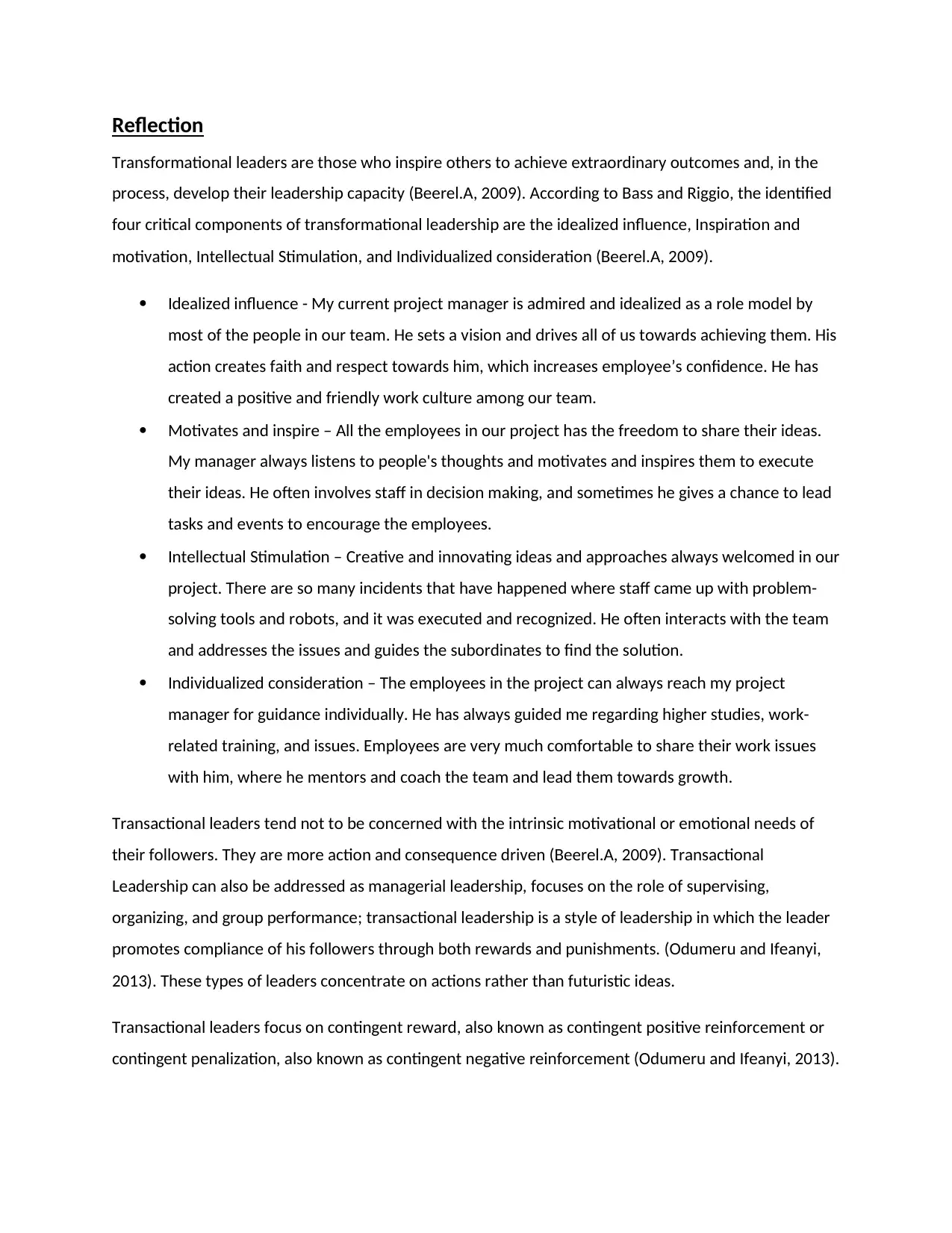
Reflection
Transformational leaders are those who inspire others to achieve extraordinary outcomes and, in the
process, develop their leadership capacity (Beerel.A, 2009). According to Bass and Riggio, the identified
four critical components of transformational leadership are the idealized influence, Inspiration and
motivation, Intellectual Stimulation, and Individualized consideration (Beerel.A, 2009).
Idealized influence - My current project manager is admired and idealized as a role model by
most of the people in our team. He sets a vision and drives all of us towards achieving them. His
action creates faith and respect towards him, which increases employee’s confidence. He has
created a positive and friendly work culture among our team.
Motivates and inspire – All the employees in our project has the freedom to share their ideas.
My manager always listens to people's thoughts and motivates and inspires them to execute
their ideas. He often involves staff in decision making, and sometimes he gives a chance to lead
tasks and events to encourage the employees.
Intellectual Stimulation – Creative and innovating ideas and approaches always welcomed in our
project. There are so many incidents that have happened where staff came up with problem-
solving tools and robots, and it was executed and recognized. He often interacts with the team
and addresses the issues and guides the subordinates to find the solution.
Individualized consideration – The employees in the project can always reach my project
manager for guidance individually. He has always guided me regarding higher studies, work-
related training, and issues. Employees are very much comfortable to share their work issues
with him, where he mentors and coach the team and lead them towards growth.
Transactional leaders tend not to be concerned with the intrinsic motivational or emotional needs of
their followers. They are more action and consequence driven (Beerel.A, 2009). Transactional
Leadership can also be addressed as managerial leadership, focuses on the role of supervising,
organizing, and group performance; transactional leadership is a style of leadership in which the leader
promotes compliance of his followers through both rewards and punishments. (Odumeru and Ifeanyi,
2013). These types of leaders concentrate on actions rather than futuristic ideas.
Transactional leaders focus on contingent reward, also known as contingent positive reinforcement or
contingent penalization, also known as contingent negative reinforcement (Odumeru and Ifeanyi, 2013).
Transformational leaders are those who inspire others to achieve extraordinary outcomes and, in the
process, develop their leadership capacity (Beerel.A, 2009). According to Bass and Riggio, the identified
four critical components of transformational leadership are the idealized influence, Inspiration and
motivation, Intellectual Stimulation, and Individualized consideration (Beerel.A, 2009).
Idealized influence - My current project manager is admired and idealized as a role model by
most of the people in our team. He sets a vision and drives all of us towards achieving them. His
action creates faith and respect towards him, which increases employee’s confidence. He has
created a positive and friendly work culture among our team.
Motivates and inspire – All the employees in our project has the freedom to share their ideas.
My manager always listens to people's thoughts and motivates and inspires them to execute
their ideas. He often involves staff in decision making, and sometimes he gives a chance to lead
tasks and events to encourage the employees.
Intellectual Stimulation – Creative and innovating ideas and approaches always welcomed in our
project. There are so many incidents that have happened where staff came up with problem-
solving tools and robots, and it was executed and recognized. He often interacts with the team
and addresses the issues and guides the subordinates to find the solution.
Individualized consideration – The employees in the project can always reach my project
manager for guidance individually. He has always guided me regarding higher studies, work-
related training, and issues. Employees are very much comfortable to share their work issues
with him, where he mentors and coach the team and lead them towards growth.
Transactional leaders tend not to be concerned with the intrinsic motivational or emotional needs of
their followers. They are more action and consequence driven (Beerel.A, 2009). Transactional
Leadership can also be addressed as managerial leadership, focuses on the role of supervising,
organizing, and group performance; transactional leadership is a style of leadership in which the leader
promotes compliance of his followers through both rewards and punishments. (Odumeru and Ifeanyi,
2013). These types of leaders concentrate on actions rather than futuristic ideas.
Transactional leaders focus on contingent reward, also known as contingent positive reinforcement or
contingent penalization, also known as contingent negative reinforcement (Odumeru and Ifeanyi, 2013).
Paraphrase This Document
Need a fresh take? Get an instant paraphrase of this document with our AI Paraphraser
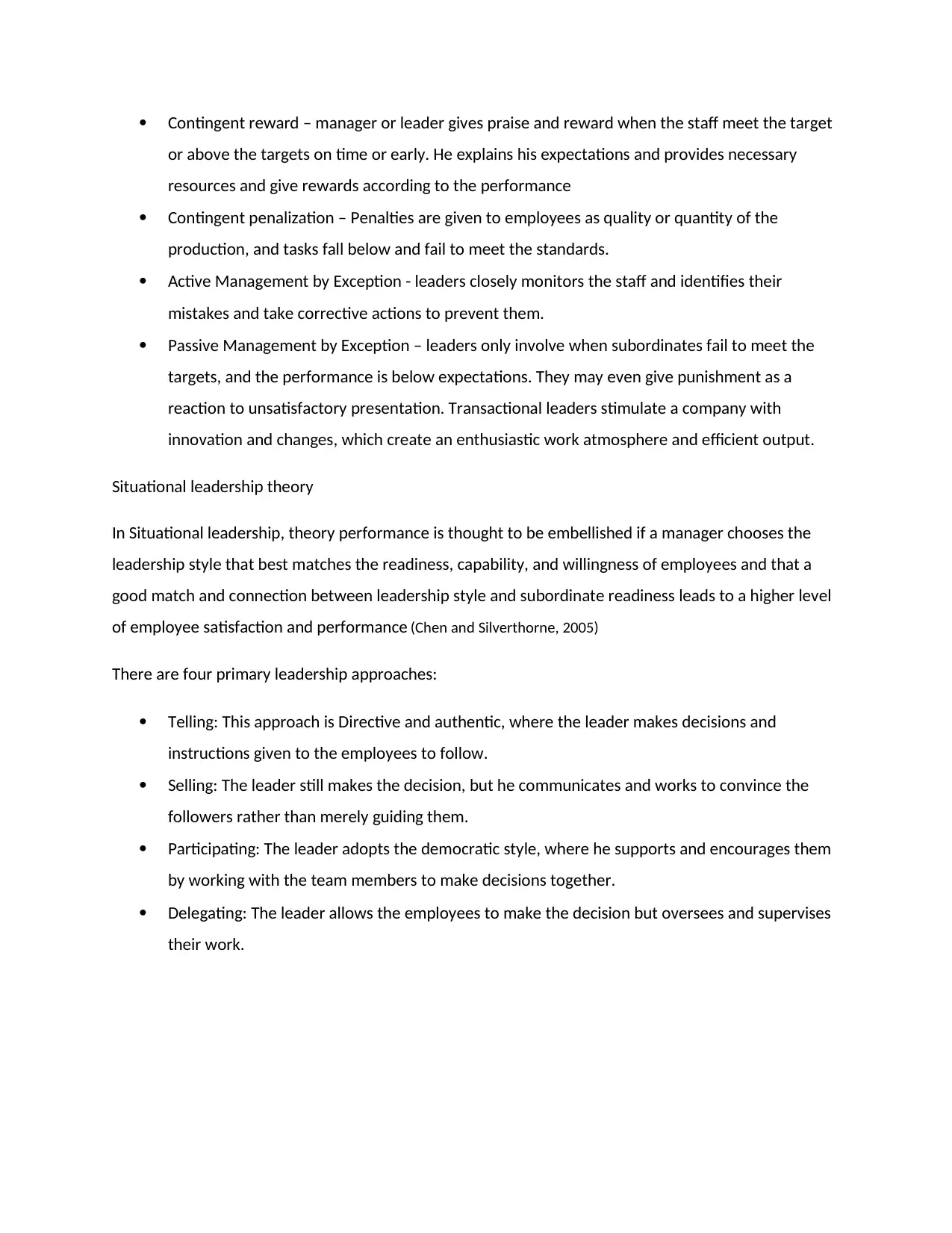
Contingent reward – manager or leader gives praise and reward when the staff meet the target
or above the targets on time or early. He explains his expectations and provides necessary
resources and give rewards according to the performance
Contingent penalization – Penalties are given to employees as quality or quantity of the
production, and tasks fall below and fail to meet the standards.
Active Management by Exception - leaders closely monitors the staff and identifies their
mistakes and take corrective actions to prevent them.
Passive Management by Exception – leaders only involve when subordinates fail to meet the
targets, and the performance is below expectations. They may even give punishment as a
reaction to unsatisfactory presentation. Transactional leaders stimulate a company with
innovation and changes, which create an enthusiastic work atmosphere and efficient output.
Situational leadership theory
In Situational leadership, theory performance is thought to be embellished if a manager chooses the
leadership style that best matches the readiness, capability, and willingness of employees and that a
good match and connection between leadership style and subordinate readiness leads to a higher level
of employee satisfaction and performance (Chen and Silverthorne, 2005)
There are four primary leadership approaches:
Telling: This approach is Directive and authentic, where the leader makes decisions and
instructions given to the employees to follow.
Selling: The leader still makes the decision, but he communicates and works to convince the
followers rather than merely guiding them.
Participating: The leader adopts the democratic style, where he supports and encourages them
by working with the team members to make decisions together.
Delegating: The leader allows the employees to make the decision but oversees and supervises
their work.
or above the targets on time or early. He explains his expectations and provides necessary
resources and give rewards according to the performance
Contingent penalization – Penalties are given to employees as quality or quantity of the
production, and tasks fall below and fail to meet the standards.
Active Management by Exception - leaders closely monitors the staff and identifies their
mistakes and take corrective actions to prevent them.
Passive Management by Exception – leaders only involve when subordinates fail to meet the
targets, and the performance is below expectations. They may even give punishment as a
reaction to unsatisfactory presentation. Transactional leaders stimulate a company with
innovation and changes, which create an enthusiastic work atmosphere and efficient output.
Situational leadership theory
In Situational leadership, theory performance is thought to be embellished if a manager chooses the
leadership style that best matches the readiness, capability, and willingness of employees and that a
good match and connection between leadership style and subordinate readiness leads to a higher level
of employee satisfaction and performance (Chen and Silverthorne, 2005)
There are four primary leadership approaches:
Telling: This approach is Directive and authentic, where the leader makes decisions and
instructions given to the employees to follow.
Selling: The leader still makes the decision, but he communicates and works to convince the
followers rather than merely guiding them.
Participating: The leader adopts the democratic style, where he supports and encourages them
by working with the team members to make decisions together.
Delegating: The leader allows the employees to make the decision but oversees and supervises
their work.
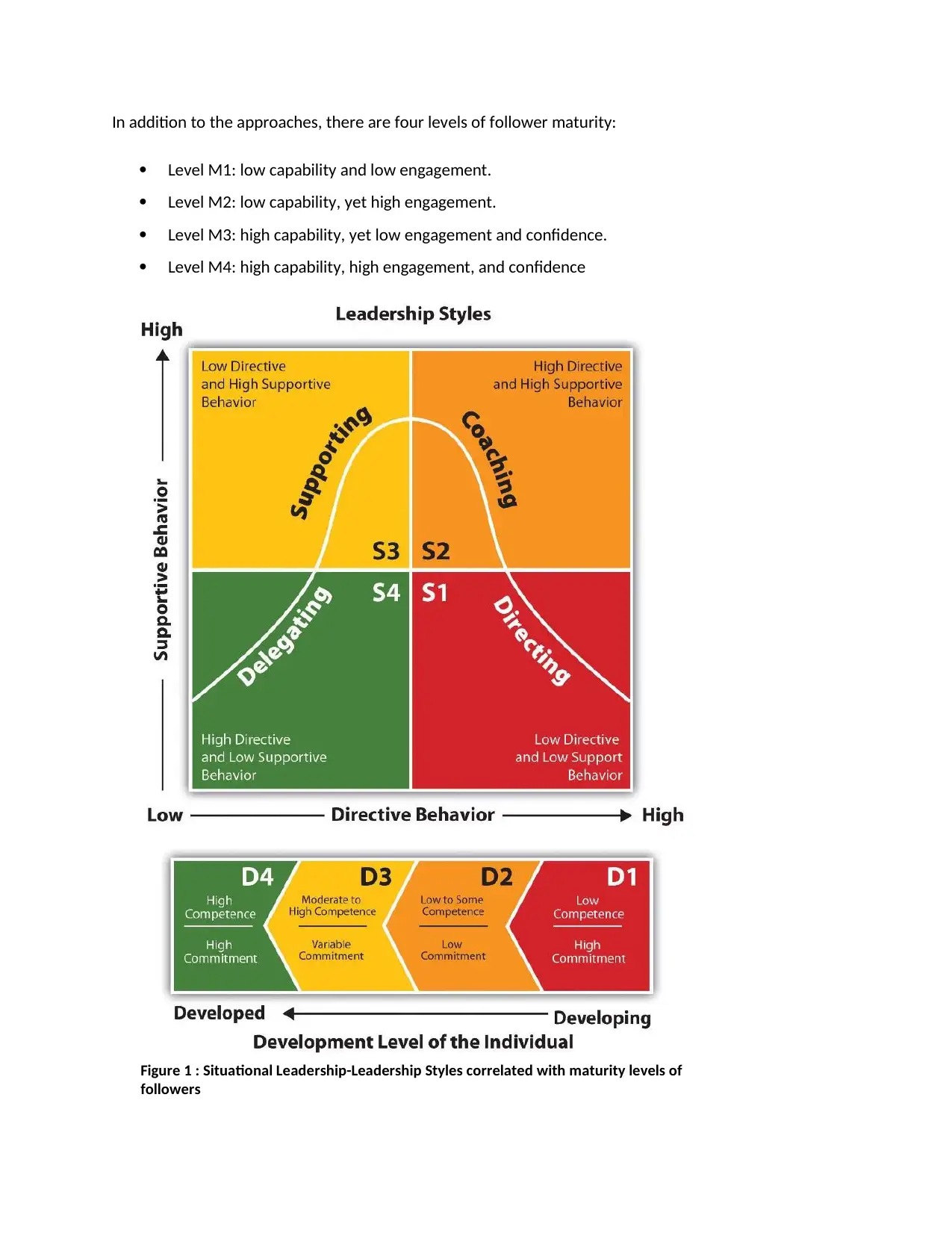
In addition to the approaches, there are four levels of follower maturity:
Level M1: low capability and low engagement.
Level M2: low capability, yet high engagement.
Level M3: high capability, yet low engagement and confidence.
Level M4: high capability, high engagement, and confidence
Figure 1 : Situational Leadership-Leadership Styles correlated with maturity levels of
followers
Level M1: low capability and low engagement.
Level M2: low capability, yet high engagement.
Level M3: high capability, yet low engagement and confidence.
Level M4: high capability, high engagement, and confidence
Figure 1 : Situational Leadership-Leadership Styles correlated with maturity levels of
followers
⊘ This is a preview!⊘
Do you want full access?
Subscribe today to unlock all pages.

Trusted by 1+ million students worldwide
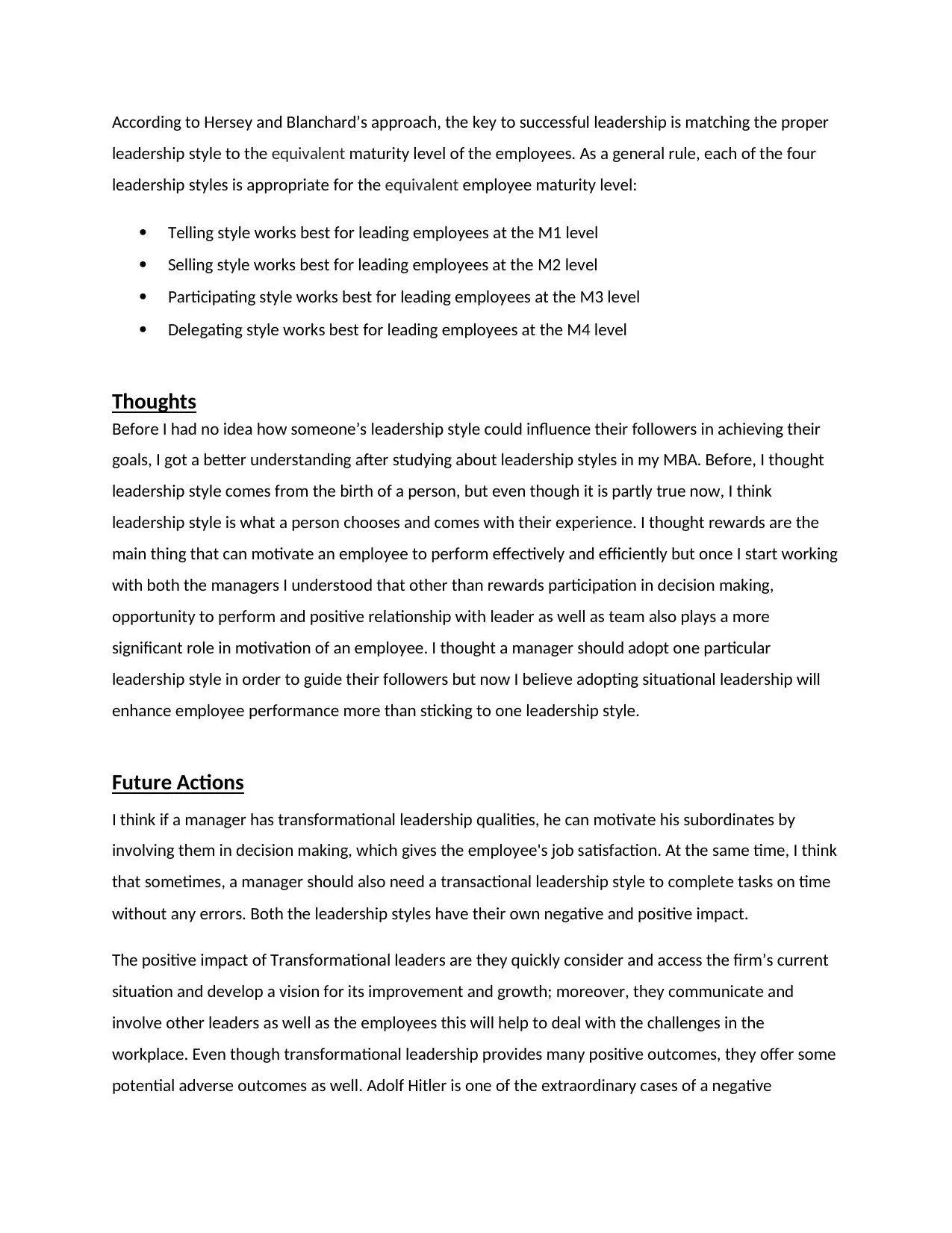
According to Hersey and Blanchard’s approach, the key to successful leadership is matching the proper
leadership style to the equivalent maturity level of the employees. As a general rule, each of the four
leadership styles is appropriate for the equivalent employee maturity level:
Telling style works best for leading employees at the M1 level
Selling style works best for leading employees at the M2 level
Participating style works best for leading employees at the M3 level
Delegating style works best for leading employees at the M4 level
Thoughts
Before I had no idea how someone’s leadership style could influence their followers in achieving their
goals, I got a better understanding after studying about leadership styles in my MBA. Before, I thought
leadership style comes from the birth of a person, but even though it is partly true now, I think
leadership style is what a person chooses and comes with their experience. I thought rewards are the
main thing that can motivate an employee to perform effectively and efficiently but once I start working
with both the managers I understood that other than rewards participation in decision making,
opportunity to perform and positive relationship with leader as well as team also plays a more
significant role in motivation of an employee. I thought a manager should adopt one particular
leadership style in order to guide their followers but now I believe adopting situational leadership will
enhance employee performance more than sticking to one leadership style.
Future Actions
I think if a manager has transformational leadership qualities, he can motivate his subordinates by
involving them in decision making, which gives the employee's job satisfaction. At the same time, I think
that sometimes, a manager should also need a transactional leadership style to complete tasks on time
without any errors. Both the leadership styles have their own negative and positive impact.
The positive impact of Transformational leaders are they quickly consider and access the firm’s current
situation and develop a vision for its improvement and growth; moreover, they communicate and
involve other leaders as well as the employees this will help to deal with the challenges in the
workplace. Even though transformational leadership provides many positive outcomes, they offer some
potential adverse outcomes as well. Adolf Hitler is one of the extraordinary cases of a negative
leadership style to the equivalent maturity level of the employees. As a general rule, each of the four
leadership styles is appropriate for the equivalent employee maturity level:
Telling style works best for leading employees at the M1 level
Selling style works best for leading employees at the M2 level
Participating style works best for leading employees at the M3 level
Delegating style works best for leading employees at the M4 level
Thoughts
Before I had no idea how someone’s leadership style could influence their followers in achieving their
goals, I got a better understanding after studying about leadership styles in my MBA. Before, I thought
leadership style comes from the birth of a person, but even though it is partly true now, I think
leadership style is what a person chooses and comes with their experience. I thought rewards are the
main thing that can motivate an employee to perform effectively and efficiently but once I start working
with both the managers I understood that other than rewards participation in decision making,
opportunity to perform and positive relationship with leader as well as team also plays a more
significant role in motivation of an employee. I thought a manager should adopt one particular
leadership style in order to guide their followers but now I believe adopting situational leadership will
enhance employee performance more than sticking to one leadership style.
Future Actions
I think if a manager has transformational leadership qualities, he can motivate his subordinates by
involving them in decision making, which gives the employee's job satisfaction. At the same time, I think
that sometimes, a manager should also need a transactional leadership style to complete tasks on time
without any errors. Both the leadership styles have their own negative and positive impact.
The positive impact of Transformational leaders are they quickly consider and access the firm’s current
situation and develop a vision for its improvement and growth; moreover, they communicate and
involve other leaders as well as the employees this will help to deal with the challenges in the
workplace. Even though transformational leadership provides many positive outcomes, they offer some
potential adverse outcomes as well. Adolf Hitler is one of the extraordinary cases of a negative
Paraphrase This Document
Need a fresh take? Get an instant paraphrase of this document with our AI Paraphraser
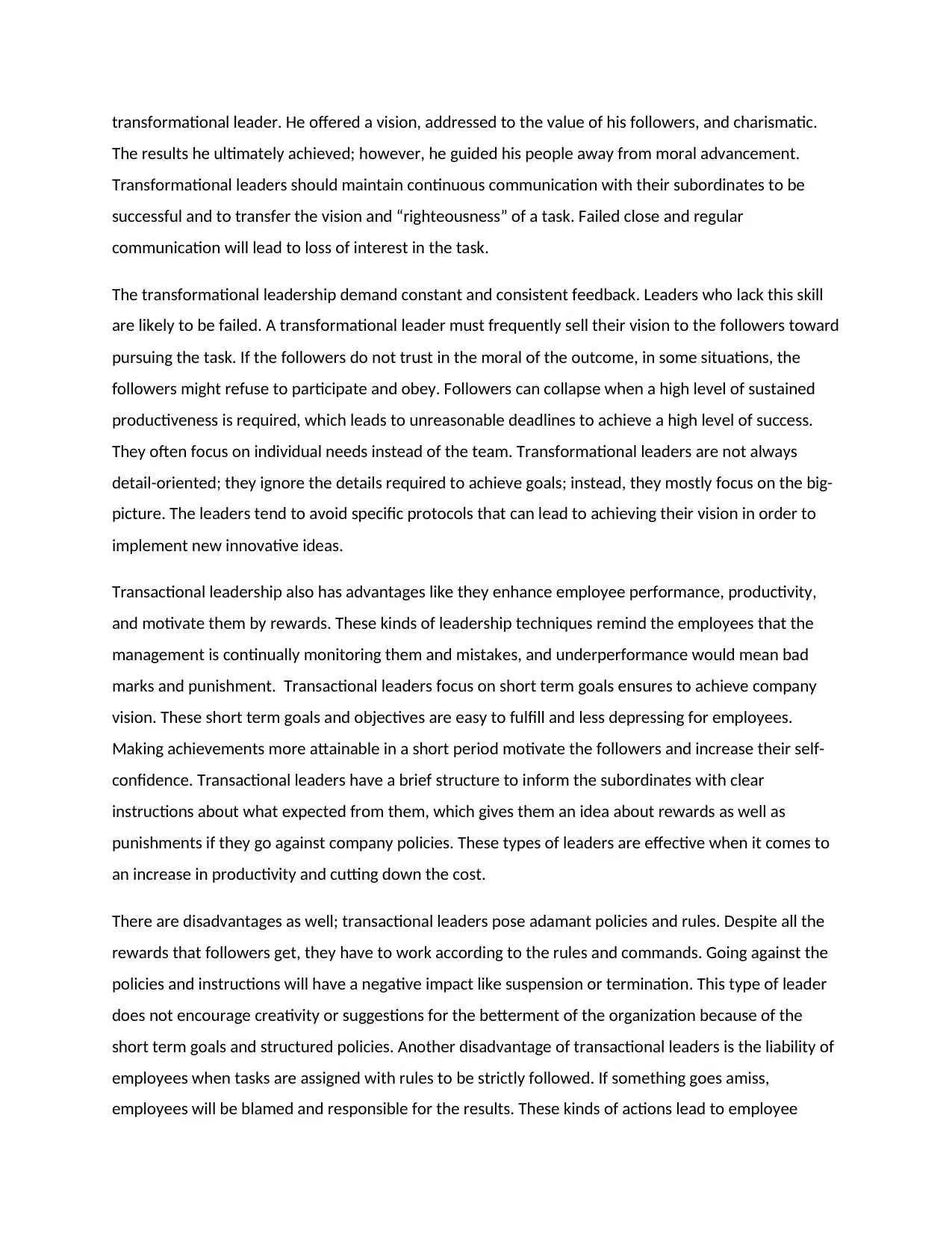
transformational leader. He offered a vision, addressed to the value of his followers, and charismatic.
The results he ultimately achieved; however, he guided his people away from moral advancement.
Transformational leaders should maintain continuous communication with their subordinates to be
successful and to transfer the vision and “righteousness” of a task. Failed close and regular
communication will lead to loss of interest in the task.
The transformational leadership demand constant and consistent feedback. Leaders who lack this skill
are likely to be failed. A transformational leader must frequently sell their vision to the followers toward
pursuing the task. If the followers do not trust in the moral of the outcome, in some situations, the
followers might refuse to participate and obey. Followers can collapse when a high level of sustained
productiveness is required, which leads to unreasonable deadlines to achieve a high level of success.
They often focus on individual needs instead of the team. Transformational leaders are not always
detail-oriented; they ignore the details required to achieve goals; instead, they mostly focus on the big-
picture. The leaders tend to avoid specific protocols that can lead to achieving their vision in order to
implement new innovative ideas.
Transactional leadership also has advantages like they enhance employee performance, productivity,
and motivate them by rewards. These kinds of leadership techniques remind the employees that the
management is continually monitoring them and mistakes, and underperformance would mean bad
marks and punishment. Transactional leaders focus on short term goals ensures to achieve company
vision. These short term goals and objectives are easy to fulfill and less depressing for employees.
Making achievements more attainable in a short period motivate the followers and increase their self-
confidence. Transactional leaders have a brief structure to inform the subordinates with clear
instructions about what expected from them, which gives them an idea about rewards as well as
punishments if they go against company policies. These types of leaders are effective when it comes to
an increase in productivity and cutting down the cost.
There are disadvantages as well; transactional leaders pose adamant policies and rules. Despite all the
rewards that followers get, they have to work according to the rules and commands. Going against the
policies and instructions will have a negative impact like suspension or termination. This type of leader
does not encourage creativity or suggestions for the betterment of the organization because of the
short term goals and structured policies. Another disadvantage of transactional leaders is the liability of
employees when tasks are assigned with rules to be strictly followed. If something goes amiss,
employees will be blamed and responsible for the results. These kinds of actions lead to employee
The results he ultimately achieved; however, he guided his people away from moral advancement.
Transformational leaders should maintain continuous communication with their subordinates to be
successful and to transfer the vision and “righteousness” of a task. Failed close and regular
communication will lead to loss of interest in the task.
The transformational leadership demand constant and consistent feedback. Leaders who lack this skill
are likely to be failed. A transformational leader must frequently sell their vision to the followers toward
pursuing the task. If the followers do not trust in the moral of the outcome, in some situations, the
followers might refuse to participate and obey. Followers can collapse when a high level of sustained
productiveness is required, which leads to unreasonable deadlines to achieve a high level of success.
They often focus on individual needs instead of the team. Transformational leaders are not always
detail-oriented; they ignore the details required to achieve goals; instead, they mostly focus on the big-
picture. The leaders tend to avoid specific protocols that can lead to achieving their vision in order to
implement new innovative ideas.
Transactional leadership also has advantages like they enhance employee performance, productivity,
and motivate them by rewards. These kinds of leadership techniques remind the employees that the
management is continually monitoring them and mistakes, and underperformance would mean bad
marks and punishment. Transactional leaders focus on short term goals ensures to achieve company
vision. These short term goals and objectives are easy to fulfill and less depressing for employees.
Making achievements more attainable in a short period motivate the followers and increase their self-
confidence. Transactional leaders have a brief structure to inform the subordinates with clear
instructions about what expected from them, which gives them an idea about rewards as well as
punishments if they go against company policies. These types of leaders are effective when it comes to
an increase in productivity and cutting down the cost.
There are disadvantages as well; transactional leaders pose adamant policies and rules. Despite all the
rewards that followers get, they have to work according to the rules and commands. Going against the
policies and instructions will have a negative impact like suspension or termination. This type of leader
does not encourage creativity or suggestions for the betterment of the organization because of the
short term goals and structured policies. Another disadvantage of transactional leaders is the liability of
employees when tasks are assigned with rules to be strictly followed. If something goes amiss,
employees will be blamed and responsible for the results. These kinds of actions lead to employee
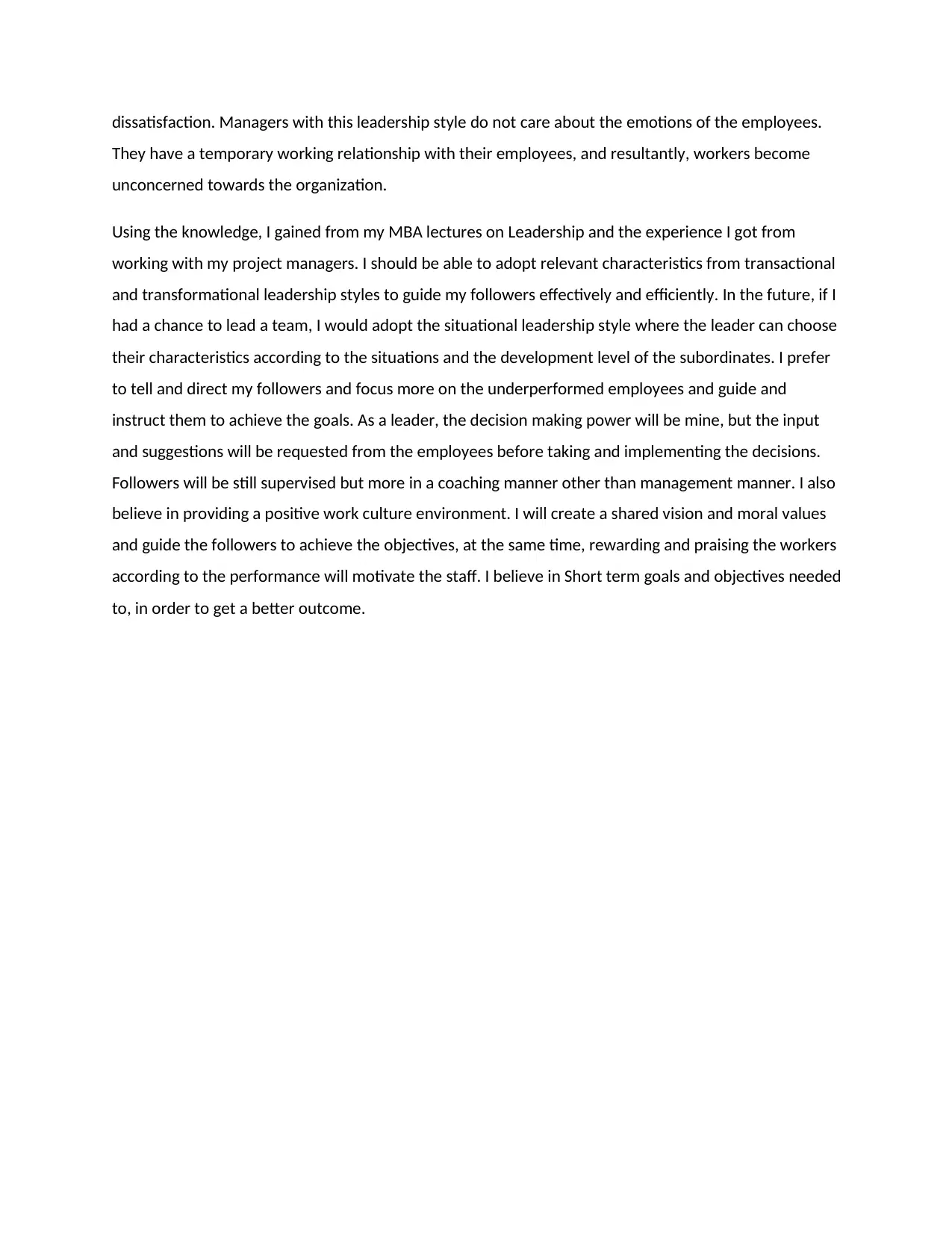
dissatisfaction. Managers with this leadership style do not care about the emotions of the employees.
They have a temporary working relationship with their employees, and resultantly, workers become
unconcerned towards the organization.
Using the knowledge, I gained from my MBA lectures on Leadership and the experience I got from
working with my project managers. I should be able to adopt relevant characteristics from transactional
and transformational leadership styles to guide my followers effectively and efficiently. In the future, if I
had a chance to lead a team, I would adopt the situational leadership style where the leader can choose
their characteristics according to the situations and the development level of the subordinates. I prefer
to tell and direct my followers and focus more on the underperformed employees and guide and
instruct them to achieve the goals. As a leader, the decision making power will be mine, but the input
and suggestions will be requested from the employees before taking and implementing the decisions.
Followers will be still supervised but more in a coaching manner other than management manner. I also
believe in providing a positive work culture environment. I will create a shared vision and moral values
and guide the followers to achieve the objectives, at the same time, rewarding and praising the workers
according to the performance will motivate the staff. I believe in Short term goals and objectives needed
to, in order to get a better outcome.
They have a temporary working relationship with their employees, and resultantly, workers become
unconcerned towards the organization.
Using the knowledge, I gained from my MBA lectures on Leadership and the experience I got from
working with my project managers. I should be able to adopt relevant characteristics from transactional
and transformational leadership styles to guide my followers effectively and efficiently. In the future, if I
had a chance to lead a team, I would adopt the situational leadership style where the leader can choose
their characteristics according to the situations and the development level of the subordinates. I prefer
to tell and direct my followers and focus more on the underperformed employees and guide and
instruct them to achieve the goals. As a leader, the decision making power will be mine, but the input
and suggestions will be requested from the employees before taking and implementing the decisions.
Followers will be still supervised but more in a coaching manner other than management manner. I also
believe in providing a positive work culture environment. I will create a shared vision and moral values
and guide the followers to achieve the objectives, at the same time, rewarding and praising the workers
according to the performance will motivate the staff. I believe in Short term goals and objectives needed
to, in order to get a better outcome.
⊘ This is a preview!⊘
Do you want full access?
Subscribe today to unlock all pages.

Trusted by 1+ million students worldwide
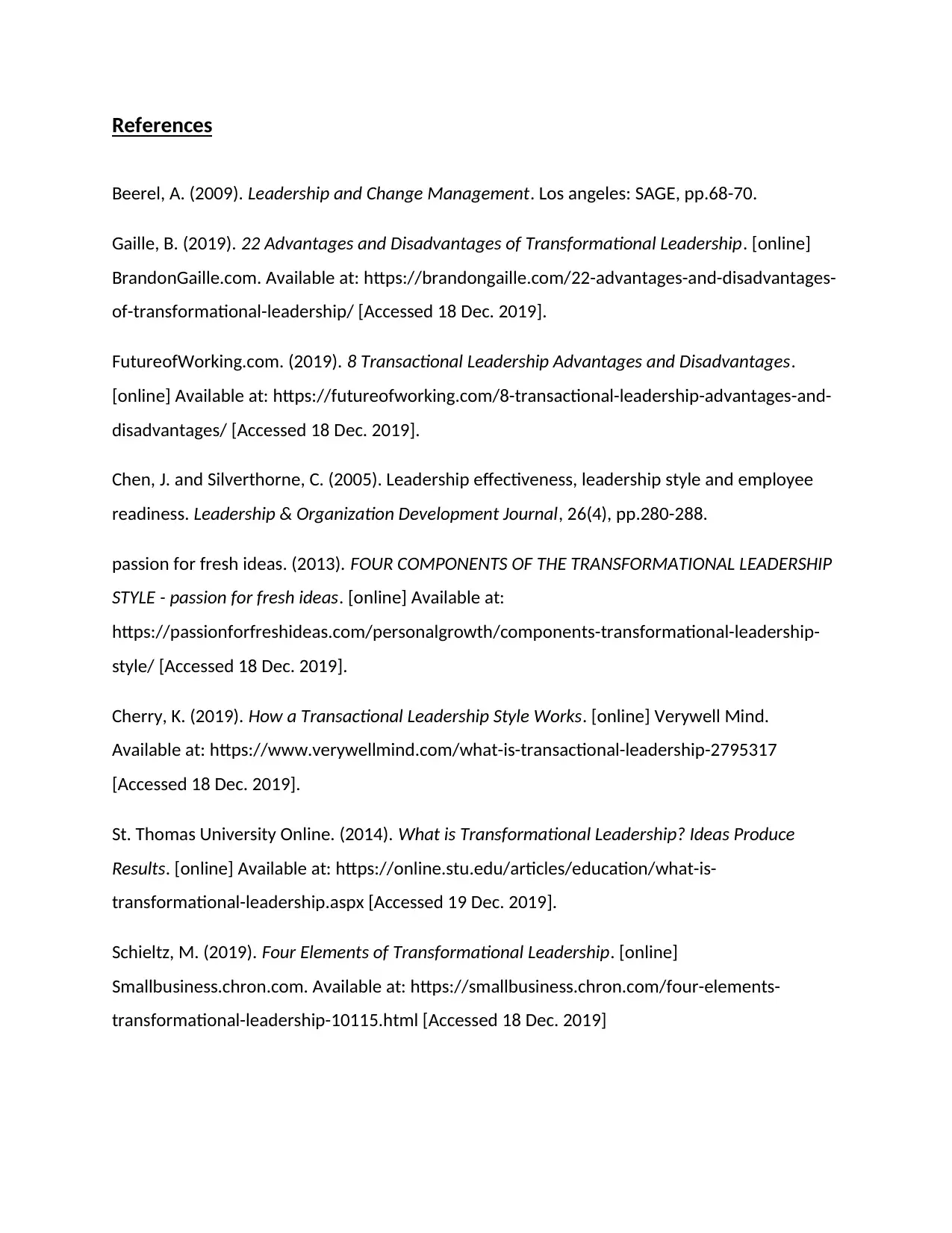
References
Beerel, A. (2009). Leadership and Change Management. Los angeles: SAGE, pp.68-70.
Gaille, B. (2019). 22 Advantages and Disadvantages of Transformational Leadership. [online]
BrandonGaille.com. Available at: https://brandongaille.com/22-advantages-and-disadvantages-
of-transformational-leadership/ [Accessed 18 Dec. 2019].
FutureofWorking.com. (2019). 8 Transactional Leadership Advantages and Disadvantages.
[online] Available at: https://futureofworking.com/8-transactional-leadership-advantages-and-
disadvantages/ [Accessed 18 Dec. 2019].
Chen, J. and Silverthorne, C. (2005). Leadership effectiveness, leadership style and employee
readiness. Leadership & Organization Development Journal, 26(4), pp.280-288.
passion for fresh ideas. (2013). FOUR COMPONENTS OF THE TRANSFORMATIONAL LEADERSHIP
STYLE - passion for fresh ideas. [online] Available at:
https://passionforfreshideas.com/personalgrowth/components-transformational-leadership-
style/ [Accessed 18 Dec. 2019].
Cherry, K. (2019). How a Transactional Leadership Style Works. [online] Verywell Mind.
Available at: https://www.verywellmind.com/what-is-transactional-leadership-2795317
[Accessed 18 Dec. 2019].
St. Thomas University Online. (2014). What is Transformational Leadership? Ideas Produce
Results. [online] Available at: https://online.stu.edu/articles/education/what-is-
transformational-leadership.aspx [Accessed 19 Dec. 2019].
Schieltz, M. (2019). Four Elements of Transformational Leadership. [online]
Smallbusiness.chron.com. Available at: https://smallbusiness.chron.com/four-elements-
transformational-leadership-10115.html [Accessed 18 Dec. 2019]
Beerel, A. (2009). Leadership and Change Management. Los angeles: SAGE, pp.68-70.
Gaille, B. (2019). 22 Advantages and Disadvantages of Transformational Leadership. [online]
BrandonGaille.com. Available at: https://brandongaille.com/22-advantages-and-disadvantages-
of-transformational-leadership/ [Accessed 18 Dec. 2019].
FutureofWorking.com. (2019). 8 Transactional Leadership Advantages and Disadvantages.
[online] Available at: https://futureofworking.com/8-transactional-leadership-advantages-and-
disadvantages/ [Accessed 18 Dec. 2019].
Chen, J. and Silverthorne, C. (2005). Leadership effectiveness, leadership style and employee
readiness. Leadership & Organization Development Journal, 26(4), pp.280-288.
passion for fresh ideas. (2013). FOUR COMPONENTS OF THE TRANSFORMATIONAL LEADERSHIP
STYLE - passion for fresh ideas. [online] Available at:
https://passionforfreshideas.com/personalgrowth/components-transformational-leadership-
style/ [Accessed 18 Dec. 2019].
Cherry, K. (2019). How a Transactional Leadership Style Works. [online] Verywell Mind.
Available at: https://www.verywellmind.com/what-is-transactional-leadership-2795317
[Accessed 18 Dec. 2019].
St. Thomas University Online. (2014). What is Transformational Leadership? Ideas Produce
Results. [online] Available at: https://online.stu.edu/articles/education/what-is-
transformational-leadership.aspx [Accessed 19 Dec. 2019].
Schieltz, M. (2019). Four Elements of Transformational Leadership. [online]
Smallbusiness.chron.com. Available at: https://smallbusiness.chron.com/four-elements-
transformational-leadership-10115.html [Accessed 18 Dec. 2019]
Paraphrase This Document
Need a fresh take? Get an instant paraphrase of this document with our AI Paraphraser
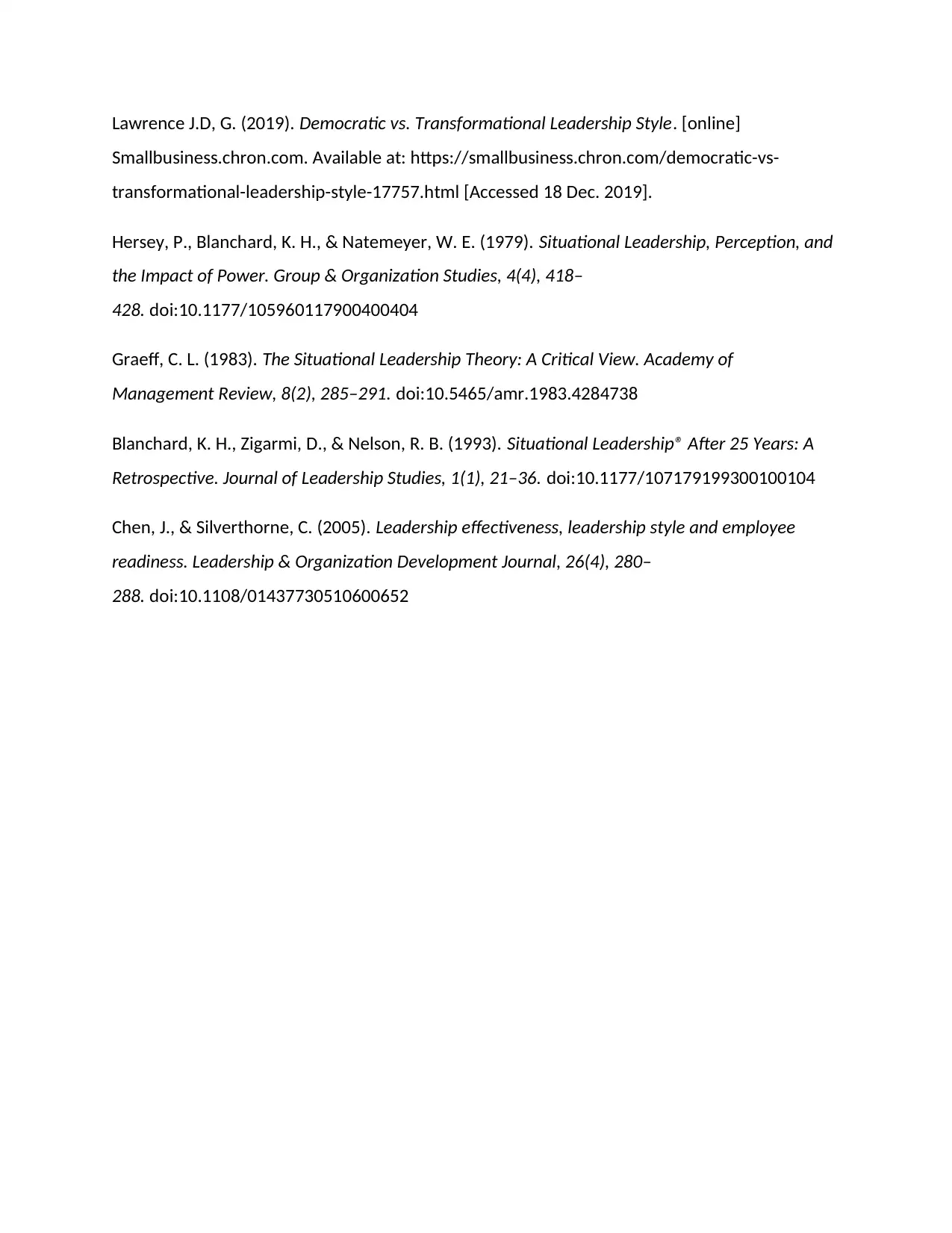
Lawrence J.D, G. (2019). Democratic vs. Transformational Leadership Style. [online]
Smallbusiness.chron.com. Available at: https://smallbusiness.chron.com/democratic-vs-
transformational-leadership-style-17757.html [Accessed 18 Dec. 2019].
Hersey, P., Blanchard, K. H., & Natemeyer, W. E. (1979). Situational Leadership, Perception, and
the Impact of Power. Group & Organization Studies, 4(4), 418–
428. doi:10.1177/105960117900400404
Graeff, C. L. (1983). The Situational Leadership Theory: A Critical View. Academy of
Management Review, 8(2), 285–291. doi:10.5465/amr.1983.4284738
Blanchard, K. H., Zigarmi, D., & Nelson, R. B. (1993). Situational Leadership® After 25 Years: A
Retrospective. Journal of Leadership Studies, 1(1), 21–36. doi:10.1177/107179199300100104
Chen, J., & Silverthorne, C. (2005). Leadership effectiveness, leadership style and employee
readiness. Leadership & Organization Development Journal, 26(4), 280–
288. doi:10.1108/01437730510600652
Smallbusiness.chron.com. Available at: https://smallbusiness.chron.com/democratic-vs-
transformational-leadership-style-17757.html [Accessed 18 Dec. 2019].
Hersey, P., Blanchard, K. H., & Natemeyer, W. E. (1979). Situational Leadership, Perception, and
the Impact of Power. Group & Organization Studies, 4(4), 418–
428. doi:10.1177/105960117900400404
Graeff, C. L. (1983). The Situational Leadership Theory: A Critical View. Academy of
Management Review, 8(2), 285–291. doi:10.5465/amr.1983.4284738
Blanchard, K. H., Zigarmi, D., & Nelson, R. B. (1993). Situational Leadership® After 25 Years: A
Retrospective. Journal of Leadership Studies, 1(1), 21–36. doi:10.1177/107179199300100104
Chen, J., & Silverthorne, C. (2005). Leadership effectiveness, leadership style and employee
readiness. Leadership & Organization Development Journal, 26(4), 280–
288. doi:10.1108/01437730510600652
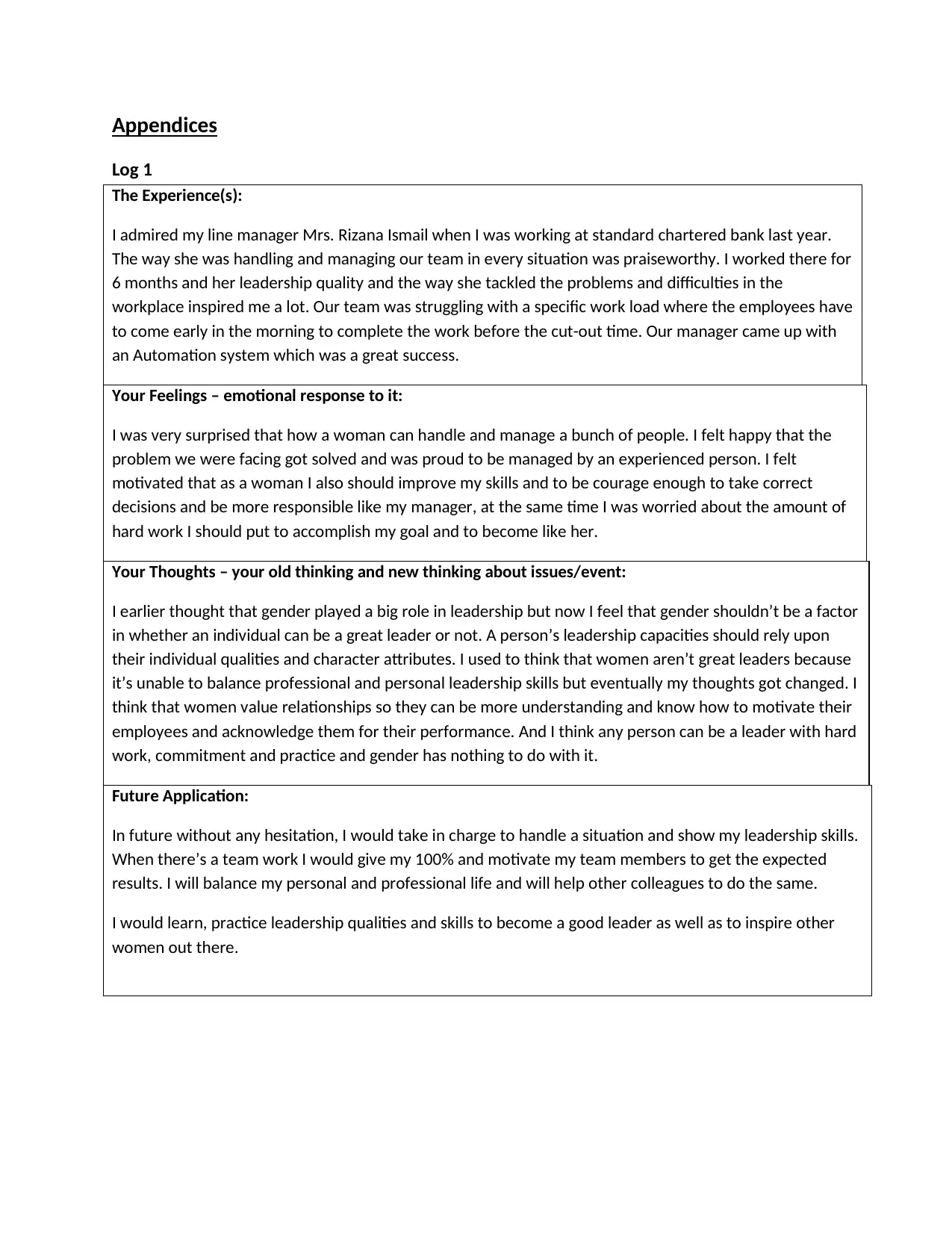
Appendices
Log 1
The Experience(s):
I admired my line manager Mrs. Rizana Ismail when I was working at standard chartered bank last year.
The way she was handling and managing our team in every situation was praiseworthy. I worked there for
6 months and her leadership quality and the way she tackled the problems and difficulties in the
workplace inspired me a lot. Our team was struggling with a specific work load where the employees have
to come early in the morning to complete the work before the cut-out time. Our manager came up with
an Automation system which was a great success.
Your Feelings – emotional response to it:
I was very surprised that how a woman can handle and manage a bunch of people. I felt happy that the
problem we were facing got solved and was proud to be managed by an experienced person. I felt
motivated that as a woman I also should improve my skills and to be courage enough to take correct
decisions and be more responsible like my manager, at the same time I was worried about the amount of
hard work I should put to accomplish my goal and to become like her.
Your Thoughts – your old thinking and new thinking about issues/event:
I earlier thought that gender played a big role in leadership but now I feel that gender shouldn’t be a factor
in whether an individual can be a great leader or not. A person’s leadership capacities should rely upon
their individual qualities and character attributes. I used to think that women aren’t great leaders because
it’s unable to balance professional and personal leadership skills but eventually my thoughts got changed. I
think that women value relationships so they can be more understanding and know how to motivate their
employees and acknowledge them for their performance. And I think any person can be a leader with hard
work, commitment and practice and gender has nothing to do with it.
Future Application:
In future without any hesitation, I would take in charge to handle a situation and show my leadership skills.
When there’s a team work I would give my 100% and motivate my team members to get the expected
results. I will balance my personal and professional life and will help other colleagues to do the same.
I would learn, practice leadership qualities and skills to become a good leader as well as to inspire other
women out there.
Log 1
The Experience(s):
I admired my line manager Mrs. Rizana Ismail when I was working at standard chartered bank last year.
The way she was handling and managing our team in every situation was praiseworthy. I worked there for
6 months and her leadership quality and the way she tackled the problems and difficulties in the
workplace inspired me a lot. Our team was struggling with a specific work load where the employees have
to come early in the morning to complete the work before the cut-out time. Our manager came up with
an Automation system which was a great success.
Your Feelings – emotional response to it:
I was very surprised that how a woman can handle and manage a bunch of people. I felt happy that the
problem we were facing got solved and was proud to be managed by an experienced person. I felt
motivated that as a woman I also should improve my skills and to be courage enough to take correct
decisions and be more responsible like my manager, at the same time I was worried about the amount of
hard work I should put to accomplish my goal and to become like her.
Your Thoughts – your old thinking and new thinking about issues/event:
I earlier thought that gender played a big role in leadership but now I feel that gender shouldn’t be a factor
in whether an individual can be a great leader or not. A person’s leadership capacities should rely upon
their individual qualities and character attributes. I used to think that women aren’t great leaders because
it’s unable to balance professional and personal leadership skills but eventually my thoughts got changed. I
think that women value relationships so they can be more understanding and know how to motivate their
employees and acknowledge them for their performance. And I think any person can be a leader with hard
work, commitment and practice and gender has nothing to do with it.
Future Application:
In future without any hesitation, I would take in charge to handle a situation and show my leadership skills.
When there’s a team work I would give my 100% and motivate my team members to get the expected
results. I will balance my personal and professional life and will help other colleagues to do the same.
I would learn, practice leadership qualities and skills to become a good leader as well as to inspire other
women out there.
⊘ This is a preview!⊘
Do you want full access?
Subscribe today to unlock all pages.

Trusted by 1+ million students worldwide
1 out of 19
Related Documents
Your All-in-One AI-Powered Toolkit for Academic Success.
+13062052269
info@desklib.com
Available 24*7 on WhatsApp / Email
![[object Object]](/_next/static/media/star-bottom.7253800d.svg)
Unlock your academic potential
Copyright © 2020–2025 A2Z Services. All Rights Reserved. Developed and managed by ZUCOL.





